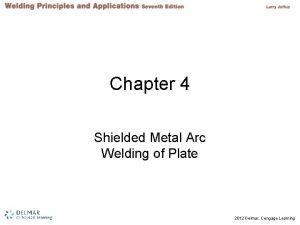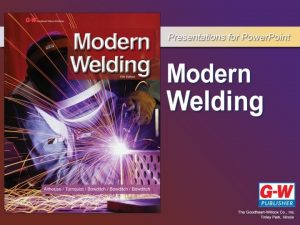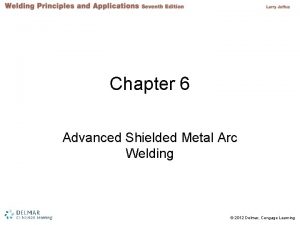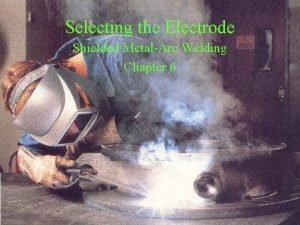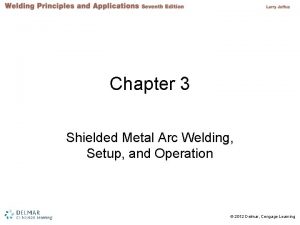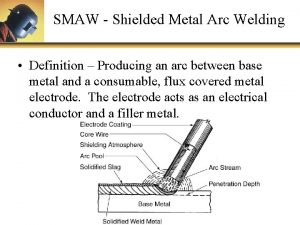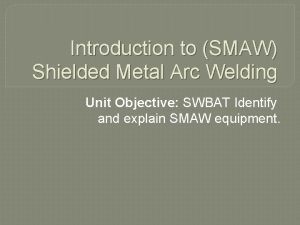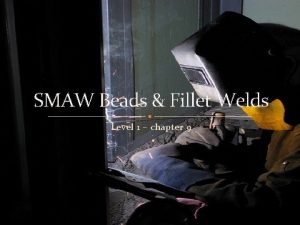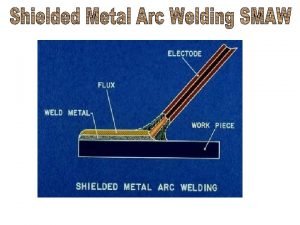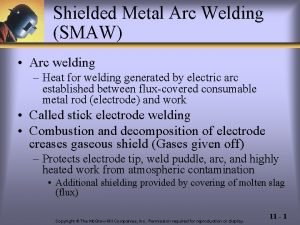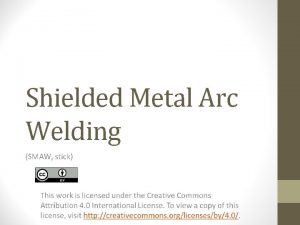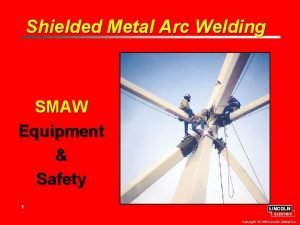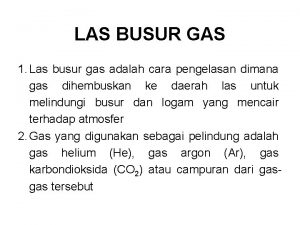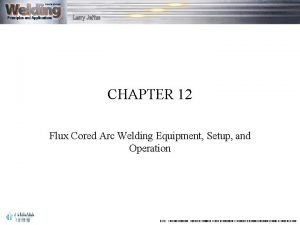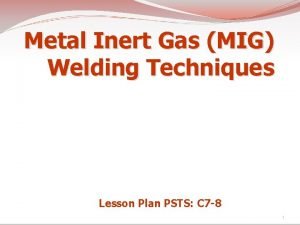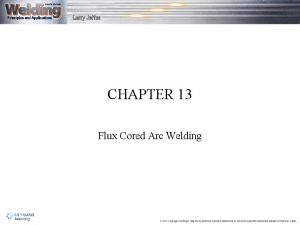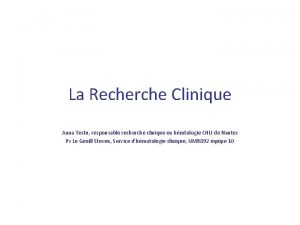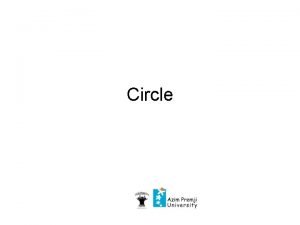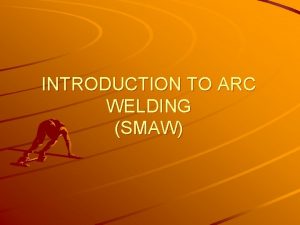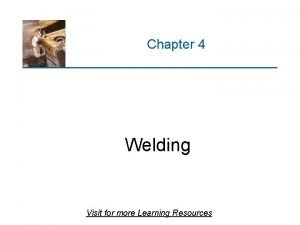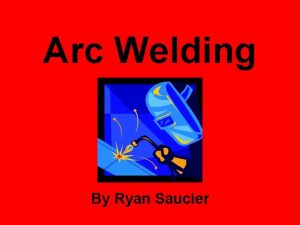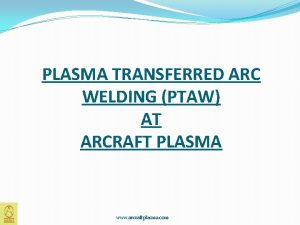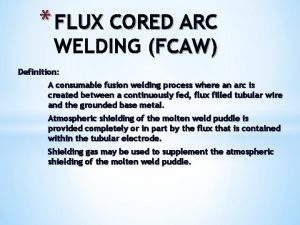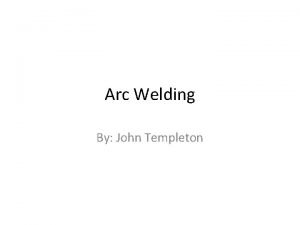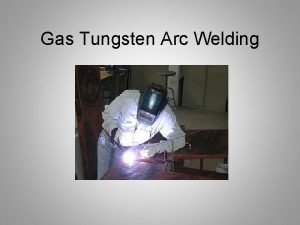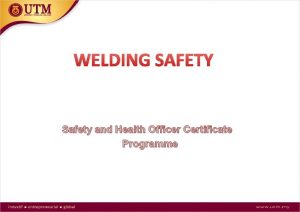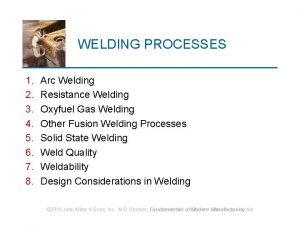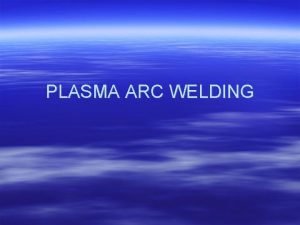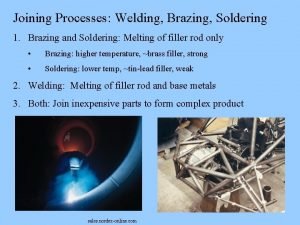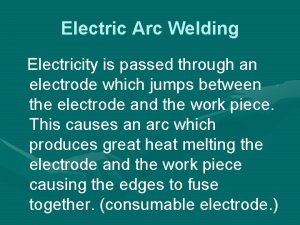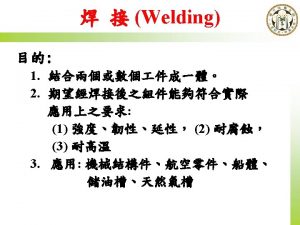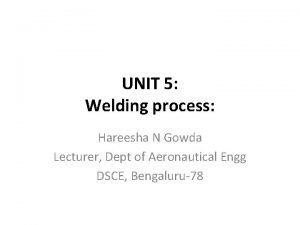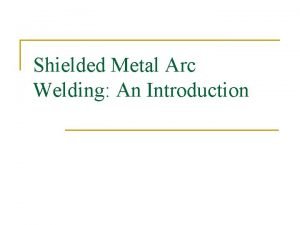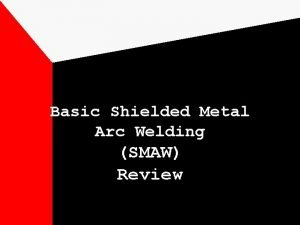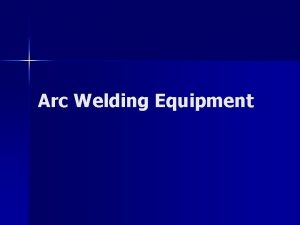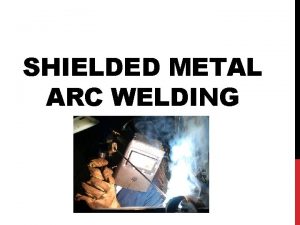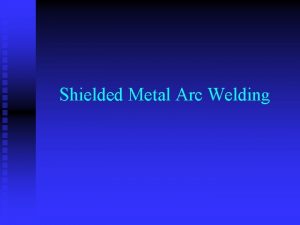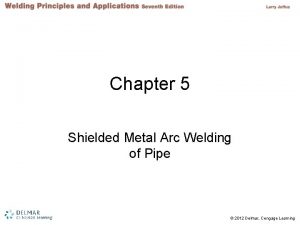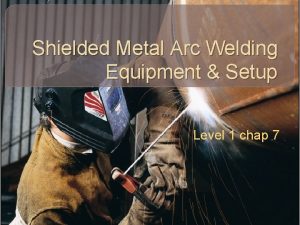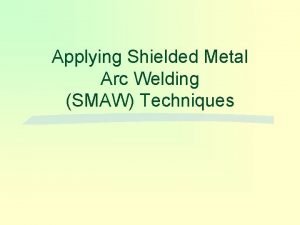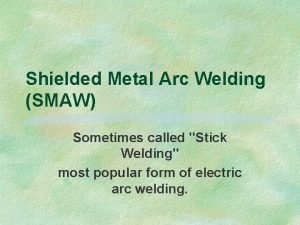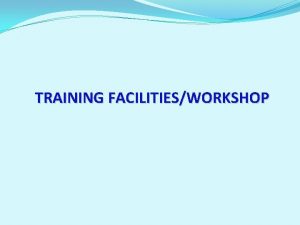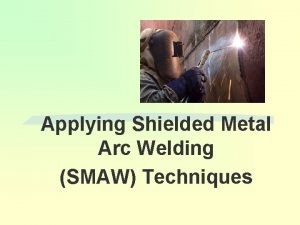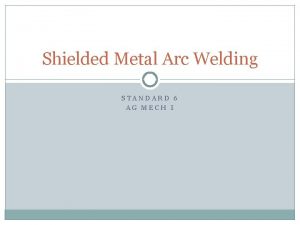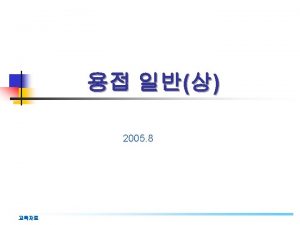Chapter 4 Shielded Metal Arc Welding of Plate



































- Slides: 35

Chapter 4 Shielded Metal Arc Welding of Plate © 2012 Delmar, Cengage Learning

Objectives • Demonstrate safe work practices • Demonstrate the ability to strike an arc at a specific point • List the problems that can result if the welding current is set too low or too high • Discuss how to select the correct diameter of welding electrode for a weld • Describe the effects of overheating a weld by comparing the bead’s shape for width, reinforcement, and appearance © 2012 Delmar, Cengage Learning

Objectives (cont'd. ) • Define arc length, and describe the effects of using too short or too long an arc length • Compare a leading electrode angle to a trailing electrode angle • Tell what characteristics of the weld bead can be controlled by the movement or weaving of the welding electrode • Demonstrate ten weave patterns for weld beads • Discuss the importance of positioning the welder and the plate properly before starting to weld © 2012 Delmar, Cengage Learning

Objectives (cont'd. ) • Give the characteristics of the three filler metal groups E 6010 and E 6011, E 6012 and E 6013, and E 7016 and E 7018 • Define stringer beads and tell how they are used • Demonstrate a vertical up stringer bead and a horizontal stringer bead • Demonstrate how to make a welded square butt joint in the flat, vertical up, and horizontal positions © 2012 Delmar, Cengage Learning

Objectives (cont'd. ) • On an edge joint, demonstrate how to make a flat weld, a vertical down weld, a vertical up weld, a horizontal weld, and an overhead weld • On an outside corner joint, demonstrate how to make a flat weld, a vertical down weld, a vertical up weld, a horizontal weld, and an overhead weld © 2012 Delmar, Cengage Learning

Objectives (cont'd. ) • Demonstrate how to make a welded lap joint in the flat position, a welded horizontal lap joint, a vertical up-welded lap joint, and an overhead-welded lap joint • Demonstrate how to make a welded tee joint in the flat, horizontal, vertical, and overhead positions © 2012 Delmar, Cengage Learning

Introduction • Shielded metal arc welding (SMAW) – Common method used to join plate • Also called stick welding – Provides high temperature and heat concentration • Allows a weld pool to be built up quickly – Filler metal from the electrode increases strength – Minimum equipment required – High-quality welds can be consistently produced © 2012 Delmar, Cengage Learning

Figure 4 -1 Striking an arc and running short beads. © Cengage Learning 2012 View Welding Video Click here to view closed captioning © 2012 Delmar, Cengage Learning

Effect of Too High or Too Low Current Settings • Each welding electrode must be operated in a specific current range – Current set too low results in poor fusion and poor arc stability • Arc length is very short • Results in frequent shorting and sticking of the electrode – Weld bead at a high amperage is wide and flat with deep penetration • Spatter is excessive • Causes electrode to discolor, crack, low red, or burn © 2012 Delmar, Cengage Learning

Electrode Size and Heat • Welding electrode size depends upon: – Welder skill and welding codes or standards – Metal thickness and size • Small diameter electrodes – Require less skill, but more time • Large diameter electrodes – May overheat: can cause a burn-through • Chill plate – Large piece of metal that absorbs excessive heat © 2012 Delmar, Cengage Learning

Figure 4 -9 The effect on the shape of the molten weld pool caused by the heat input. © Cengage Learning 2012 © 2012 Delmar, Cengage Learning

Arc Length • Distance the arc jumps from the end of electrode to the plate or weld pool surface – To maintain a constant arc length: electrode must be lowered continuously – Narrow range for the arc length to remain stable – Higher settings must be within the amperage range for the specific electrode © 2012 Delmar, Cengage Learning

Figure 4 -11 Welding with too long an arc length. Larry Jeffus. View Welding Video Click here to view closed captioning © 2012 Delmar, Cengage Learning

Electrode Angle • Measured from electrode to surface of the metal – Leading electrode angle: pushes molten metal and slag ahead of the weld – Flat position: caution must be taken to prevent cold lap and slag inclusion – Rapid cooling: prevents the metals from fusing together © 2012 Delmar, Cengage Learning

Electrode Angle (cont'd. ) • Preventing cold lap and slag inclusions: – Use as little leading angle as possible – Ensure arc melts the base metal completely – Use a penetrating-type electrode – Move arc back and forth across molten weld pool to fuse both edges © 2012 Delmar, Cengage Learning

Electrode Angle (cont'd. ) • Trailing electrode angle – Pushes molten metal away from leading edge of pool • Solidifies toward the back – Molten metal is forced away from bottom of weld • Arc melts more of the base metal • Reinforces weld © 2012 Delmar, Cengage Learning

Figure 4 -21 Welding with a trailing angle. Larry Jeffus. View Welding Video Click here to view closed captioning © 2012 Delmar, Cengage Learning

Electrode Manipulation • Weaving the welding electrode – Controls several bead characteristics • • Penetration Buildup Width Porosity Undercut Overlap Slag inclusion © 2012 Delmar, Cengage Learning

Electrode Manipulation (cont'd. ) • Weave pattern for each weld – Personal choice of the welder – Some patterns are especially helpful for specific welding situations – Many weave patterns are available © 2012 Delmar, Cengage Learning

Figure 4 -23 Weave patterns. © Cengage Learning 2012 © 2012 Delmar, Cengage Learning

Position of the Welder and the Plate • Welder – Should be in a relaxed, comfortable position before starting to weld • Welding helmet is down – Welder is blind to surroundings • Several factors led to swaying – Lean against or hold a stable object • Find most comfortable angle © 2012 Delmar, Cengage Learning

Practice Welds • Grouped according to: – Type of joint – Type of welding electrode • Instructor or welder – Selects order in which welds are made • Students – Find it easier to start with butt joints – Flat position allows welder to build skills slowly © 2012 Delmar, Cengage Learning

Electrodes • Arc welding electrodes used for practice welds are grouped into three filler metal classes – F 3 E 6010 and E 6011 electrodes • Cellulose-based flux – F 2 E 6012 and E 6013 electrodes • Rutile-based flux – F 4 E 7016 and E 7018 electrodes • Mineral-based flux • Should be the last choice © 2012 Delmar, Cengage Learning

Stringer Beads • Characteristics – Straight weld bead with little or no side-to-side electrode movement – Used to practice maintaining arc length and electrode angle – Should be straight – Easily made once the welder develops the ability to view the entire welding zone © 2012 Delmar, Cengage Learning

Square Butt Joint • Made by tack welding two flat pieces of plate together – Root opening: space between the plates • Changing the root opening affects penetration • Excessively large openings can cause burn-through © 2012 Delmar, Cengage Learning

Figure 4 -43 Square butt joint in the flat position. © Cengage Learning 2012 © 2012 Delmar, Cengage Learning

A B FIGURE 4 -44 (A) After the arc is established, hold it in one area long enough to establish the size of molten weld pool desired. (B) Weld back over the arc strike to melt it into the weld. A & B Larry Jeffus. View Welding Video Click here to view closed captioning © 2012 Delmar, Cengage Learning

Edge Weld • Made by placing the edge of the plate evenly – Plates should be clamped tightly together – Make tack welds to hold the plates together – Size of weld should equal the thickness of the plate being joined – Weld bead should have a slight buildup © 2012 Delmar, Cengage Learning

FIGURE 4 -49 Make tack welds at the ends of the joint. © Cengage Learning 2012 © 2012 Delmar, Cengage Learning

Outside Corner Joint • Made by placing the plates at a 90 degree angle to each other – Make small tack welds – Weld bead should completely fill the V-groove formed by the plates – Slightly convex surface buildup – Back side can be used to practice fillet welds © 2012 Delmar, Cengage Learning

Lap Joint • Made by overlapping edges of the two plates – Can be welded on one side or both sides with a fillet weld – Buildup should equal the thickness of the plate – Good weld has smooth transition from the plate to the surface of the weld © 2012 Delmar, Cengage Learning

FIGURE 4 -69 Lap joint. © Cengage Learning 2012 © 2012 Delmar, Cengage Learning

Tee Joint • Made by tack welding one piece of metal on another piece of metal at a right angle – Heat is not distributed uniformly between both plates – Most heat should be directed toward the base plate – Can be strong if welded on both sides – Flat or slightly concave appearance © 2012 Delmar, Cengage Learning

Figure 4 -83 Tee joint in the flat position. © Cengage Learning 2012 © 2012 Delmar, Cengage Learning

Summary • Shielded metal arc welding – Referred to as stick welding • Stick shape of electrode • Tendency of electrode to stick to the workpiece • Difficult to view entire welding zone – Developing visual skill is essential • Takes time and practice • Objectively inspecting work – Enhances skills © 2012 Delmar, Cengage Learning
 Chill plate welding definition
Chill plate welding definition Arc
Arc Dcen in welding
Dcen in welding Chapter 6 shielded metal arc welding
Chapter 6 shielded metal arc welding Fast fill electrodes
Fast fill electrodes Chapter 3 shielded metal arc welding
Chapter 3 shielded metal arc welding Shielded metal arc welding (smaw) definition
Shielded metal arc welding (smaw) definition Introduction of smaw
Introduction of smaw Beads and fillet welds
Beads and fillet welds Parts of a welding process (smaw)
Parts of a welding process (smaw) Arc length welding definition
Arc length welding definition Shielded metal arc welding definition
Shielded metal arc welding definition Smaw tools
Smaw tools Las busur gas
Las busur gas G in welding
G in welding Mig weld technique
Mig weld technique Chapter 13 smaw horizontal position
Chapter 13 smaw horizontal position Arc promoteur vs arc investigateur
Arc promoteur vs arc investigateur Minor segment of a circle
Minor segment of a circle Minar arc
Minar arc Arc emu88 com arc info 08 100008 html
Arc emu88 com arc info 08 100008 html Introduction of arc welding
Introduction of arc welding Tig (tungsten inert gas)
Tig (tungsten inert gas) Ppe for arc welding
Ppe for arc welding Plasma transferred arc
Plasma transferred arc Flux welding definition
Flux welding definition Welding objectives
Welding objectives Joan of arc map
Joan of arc map Preflow welding definition
Preflow welding definition Conclusion of arc welding
Conclusion of arc welding Resistance welding advantages and disadvantages
Resistance welding advantages and disadvantages Micro plasma welder
Micro plasma welder Resistance arc welding
Resistance arc welding Principle of electric arc welding
Principle of electric arc welding Resistance arc welding
Resistance arc welding Principle of welding
Principle of welding
